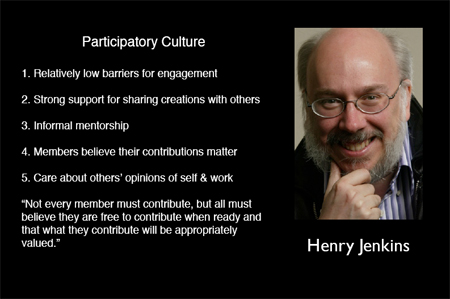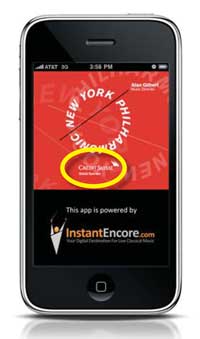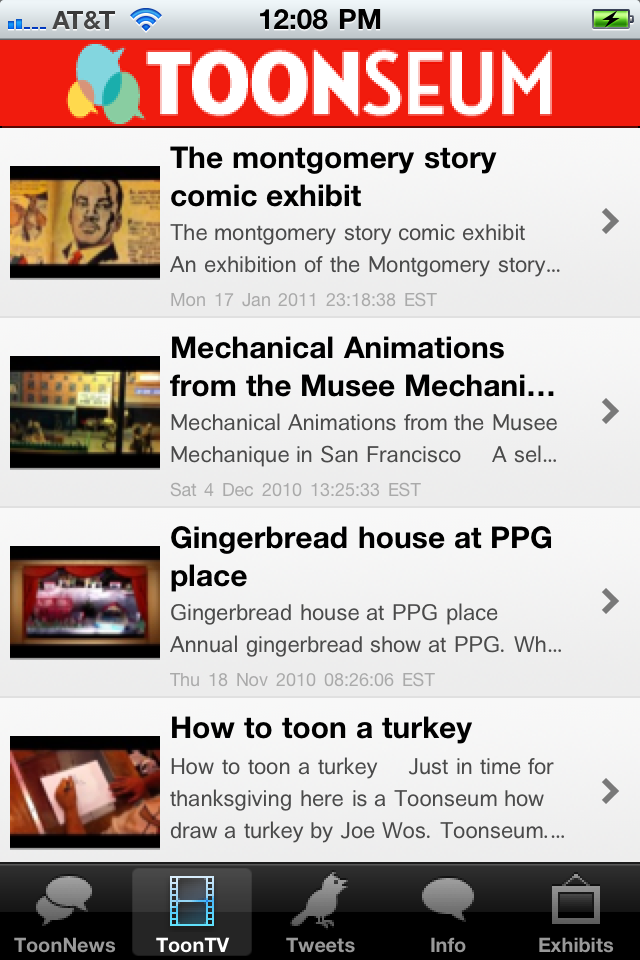Some tech+arts news that you do not want miss.
TechSoup launches Annual Digital Storytelling contest!
Whether they know it or not, every organization has a story to tell. But sometimes, it just so happens that this story is lost amid the frenetic activities of day-to-day work, and soon finds itself sitting quietly in the old forgotten folder of organizational history. Well, the month of February is the time to retrieve that story and subject it to some digital editing. This is because TechSoup, an organization that enables non profits to achieve their mission through technological solutions, has decided that some stories are best told digitally!
Recently, TechSoup launched its Annual Digital Storytelling contest which, “combines professional instruction and friendly competition into a hands-on media-making project.” Over the month of February,“TechSoup Global will host a series of interactive events including Twitter Chats, live webinars, and trainings designed to help nonprofits produce a one-minute video or five-picture Flickr slideshow that tells the story of its organization.” Yes, a minute or five pictures is all you have!
http://www.youtube.com/watch?v=ccCwQeAo4l4
TechSoup will accept submissions through February 29th, and in March, a panel of judges will select the organizations with the very best videos and “take their digital storytelling to the next level.” Another interesting and fun aspect is the Audience Choice Award, where “winning and notable submissions will be screened in San Francisco and live-streamed online through SecondLife as a special “red carpet” event on March 28, 2012.”
TechSoup’s competition is beneficial to not-for-profit organizations because stories are one of the most engaging ways to raise awareness and gather support. If an organization has a compelling story, people will listen. Better yet, if an organization can narrate it digitally, people will not only listen but they will also share it! And if the vast and ever expanding YouTube community is pleased, it might just go viral!
So non profits, make haste! You have a month and at most, a minute!
Videos to make your Wednesday less like Wednesday and more like Friday
It's Wednesday, sigh. To help with your mid-week blues, here are a few humorous and just plain cool videos. Ever wonder…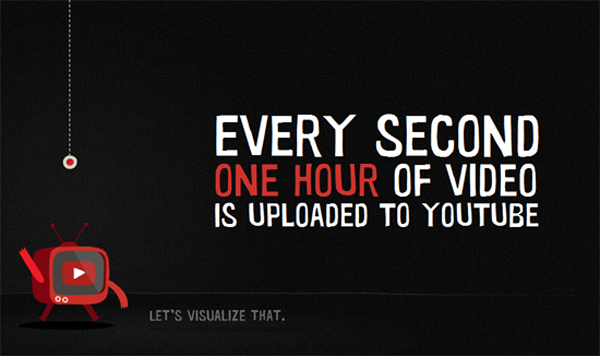 …what it would be like to work for Twitter? We regularly emphasize the benefits of Twitter and other social media networks for arts managers, fundraisers, developers, marketers, PR personnel, etc. So today I offer a break from the usual discussion about Twitter and instead, an “over-budget,” under-informative and comical video highlighting the Twitter office experience featuring Twitter CEO Dick Costolo…
…what it would be like to work for Twitter? We regularly emphasize the benefits of Twitter and other social media networks for arts managers, fundraisers, developers, marketers, PR personnel, etc. So today I offer a break from the usual discussion about Twitter and instead, an “over-budget,” under-informative and comical video highlighting the Twitter office experience featuring Twitter CEO Dick Costolo…
[embed]http://www.youtube.com/watch?v=vccZkELgEsU[/embed]
…how much video is uploaded to YouTube a day? Then check out this website that visualizes just how much video it is in comparison to other worldly and environmental phenomena.
[embed]http://www.youtube.com/watch?v=sHPfc6whaSk[/embed]
…about a popuphood? It’s exactly what it sounds like, a neighborhood or block of pop-up stores. But these aren’t your typical, temporary pop-up stores. In an urban initiative to revitalize the historic Old Oakland neighborhood in Oakland, California, popuphood is providing six retail store owners with free rent to occupy vacant storefronts in the neighborhood. The ultimate goal is for the six stores to be successful enough at this location to sign a long term lease upon the close of the first six months. Innovation in economic and urban development at its very best.
[embed]http://vimeo.com/evakolenko/popuphood[/embed]
Hope these ideas make your Wednesday all the more pleasant!
Performing Arts Legacies Online
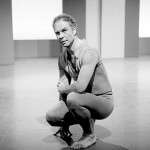 Recently the Merce Cunningham Dance Company shut down following the death of Merce Cunningham. The action taken by the founder are somewhat unique in the world of the arts and there have been observations of what this means. Meanwhile the content of the Merce Cunningham Company, at least in part can still be found online through various video projects and the archive left by the company through the Living Legacy Plan and maintained by the Merce Cunningham Trust. The continued availability of this content is carrying on the legacy in the true spirit of its founder who frequently wrote of the transitory nature of his performance and was a student of Buddhist philosophy.
Recently the Merce Cunningham Dance Company shut down following the death of Merce Cunningham. The action taken by the founder are somewhat unique in the world of the arts and there have been observations of what this means. Meanwhile the content of the Merce Cunningham Company, at least in part can still be found online through various video projects and the archive left by the company through the Living Legacy Plan and maintained by the Merce Cunningham Trust. The continued availability of this content is carrying on the legacy in the true spirit of its founder who frequently wrote of the transitory nature of his performance and was a student of Buddhist philosophy.
Further performances have resided online for years through projects like On The Boards TV which is currently celebrating its two year anniversary with a sale of online content. The content can be accessed through one time rental, purchase, and through subscription and is high quality, having been shot on 4-5 hi-definition cameras. Through content providers like On The Boards TV and do it yourself online venues such as YouTube and Vimeo the amount of online performing arts content has grown significantly. Artists are gradually recognizing that real content online is critical for accessing new audiences and maximizing market penetration.
Innovation in the field of dance and theater can go deeper than this. Critics have noticed a trend at fringe festivals of micro-performances and intimate theater. While artists seem to be taking advantage of physical spaces for the time being, the possibilities for using digital spaces are increasing everyday. The idea of doing live performances online has certainly received attention. The growth of services such as Skype make interfacing virtually and therefore using these same services as a performance venue more likely every year.
Coming Soon - MOCA TV
Wanna check out a documentary on street artists? Maybe an interactive, educational art program? Turn your dial to YouTube, and check out the new channel from the Museum of Contemporary Art (MoCA) in Los Angeles, called MOCA TV. Part of YouTube’s original programming initiative, MOCA TV is the first contemporary art and culture channel in the programming. It will be “aggregating, curating and generating the strongest artistic content from around the world” according to MOCA TV Channel Executive Jeffrey Deitch. MOCA TV original programming will feature global art news, art and music, art and fashion, artists in the studio (think MTV “Cribs” style), and aforementioned educational pieces in a series called “MOCA Univerisity”.
Deitch referred to MOCA TV as “the ultimate digital extension of the museum”, which has us curious about this growing digitization of art museums. The Walker Art Center’s new magazine-style website, increasingly sophisticated web exhibitions around the world, and MOCA TV point to general embrace of modern technologies.
MOCA TV has a July 2012 release date, so we have a while before we start streaming any shows. Shepard Fairey’s design studio is doing the graphic identity and an extensive social networking campaign promises MOCA TV will be cool and on point with tech-savvy Millennials. In the mean time, what original arts programming do you like to enjoy on YouTube?
The Art of Participatory Culture - Learning to Play WITH Our Audiences
This article was originally a speech for TEDxMichiganAve delivered by David Dombrosky on May 7, 2011 in Chicago, Illinois.
One of my favorite quotes comes from Confucius. He said, “Tell me, and I will forget. Show me, and I may remember. Involve me, and I will understand.” This quote has become one of my touchstones because it reminds me that: life is experiential, and the most resonant experiences in my life were ones in which I was an active participant. The first time I sang a solo for a public audience. Writing and performing a solo theatrical performance in college. Learning how to tango earlier this year.
If the arts community agrees that we want audiences to have deeply resonant experiences with the arts, then the question arises, “How can artists and arts organizations go beyond telling their audiences about the work or showing the work to patrons and actually INVOLVE them in the work?”
Technological advances over the past decade have propelled us into a highly participatory culture, wherein individuals no longer simply consume culture, but they now actively produce and contribute to culture. In 2006, media scholar Henry Jenkins and his colleagues published a white paper entitled Confronting the Challenges of a Participatory Culture in which they described five defining elements for participatory culture.
With this article, I would like to address the question of how artists and arts organizations can involve audiences in their work by highlighting how a number of artists and organizations exemplify the defining elements of participatory culture.
#1 – “A participatory culture has relatively low barriers to artistic expression and civic engagement.”
We see evidence of this every day. The number of free web tools and mobile apps that have been released over the past decade is astronomical. With each successive release, the barrier to artistic expression and engagement is lowered that much more.
One recently released, free tool called Broadcastr allows people to record 3-minute audio segments and pin them to specific locations on a map that is available on their website as well as through their mobile application.
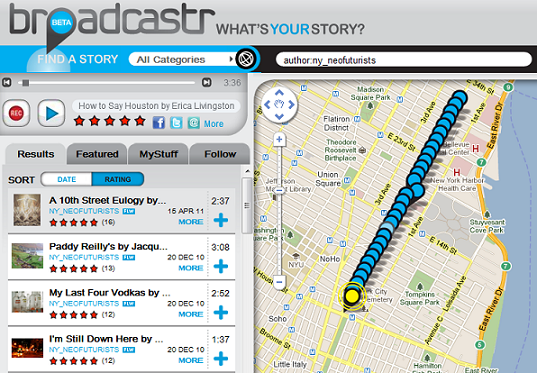
Many of you may know the Neo-Futurists, a theatre performance group originally established here in Chicago. Their New York City chapter has a show called Too Much Light Makes the Baby Go Blind which contains 30 plays performed in 60 minutes. Earlier this year, they used Broadcastr to create 30 plays in 30 blocks. So if you go to Second Avenue in Manhattan, you can walk from Houston Street to 29th Street and experience 30 location-specific, interactive pieces of audio content. Some of them direct you to do things, some of them are little songs, some of them are plays with multiple voices, and some of them reference their locations very directly.
The technology required to do this? Either a computer with speakers and a microphone OR a smartphone. That’s it.
#2 - A participatory culture has strong support for creating and sharing one’s creations with others
Over the past two years, choral composer Eric Whitacre has worked with singers from around the world to create “virtual choirs” for the performance of his compositions. Participating singers download a PDF version of the sheet music for their vocal part. They watch a YouTube video of Whitacre conducting the music, record their vocal tracks, then send the tracks to Whitacre for final editing. Whitacre and his producer then combine all of the vocal tracks together into a single audio composition and syncs it with a video featuring a virtual riser with the floating faces of each of the singers performing the piece.
His most recent virtual choir composition entitled “Sleep” features 2052 singers from 58 different countries. As of today, the video has been viewed nearly 500,000 times on YouTube. His 2009 virtual choir composition “Lux Aurumque” has had over 2.4 million views.
#3 - A participatory culture has some type of informal mentorship whereby what is known by the most experienced is passed along to novices
One organization which exemplifies this element is the San Francisco Symphony. With their Community of Music Makers program, the symphony serves amateur adult musicians and promotes active participation in music-making and lifelong learning. Community of Music Makers includes workshops and events for amateur vocalists and instrumentalists in symphony’s performance hall, where participants are able to improve their skills. They also receive live and online coaching sessions from the symphony’s musicians and artistic staff. A chamber music convening service serves as a clearinghouse to help individual players and ensembles connect each other and identify performance opportunities in the local community.
The lesson here? Learn to love amateurs as they are likely to be a strong core from which to further develop your audience.
#4 – In a participatory culture, members believe that their contributions matter.
The Brooklyn Museum pioneered crowd-curation in 2008 with its photography exhibition Click! First launched through an open call for artists to submit photos related to the theme of “The Changing Faces of Brooklyn,” the artwork was then made available online for anyone to curate. This year, they are taking another spin on this concept with the exhibition Split Second: Indian Paintings, which invited the Brooklyn Museum’s online community to participate in a project that will result in a small installation of Indian paintings from the Museum’s permanent collection in July 2011.
The first stage of the project explores split-second reactions: in a timed trial, participants were asked to select which painting they prefer from a randomly generated pair of images. Next, participants were asked to write in their own words about a painting before rating its appeal on a scale. In the final stage, participants were asked to rate a work of art after being given unlimited time to view it alongside typical interpretive text. Each part of the exercise aims to examine how a different type of information—or a lack thereof—might affect a person's reaction to a work of art.
Once the exhibit opens in July 2011, visitors will be able to view a small selection of the paintings that generated the most controversial and dynamic responses during the evaluation process, accompanied by a visualization and analysis of the data collected.
With both of these experiments from the museum, the online participants had a clear understanding of how their contributions would matter to the overall project.
In April of this year, choreographer Jonah Boaker debuted FILTER at the Ferst Center for the Performing Arts at Georgia Tech University in Atlanta. FILTER explores how the audience can serve as a collaborative filter for the performance through the use of a mobile application.
Boaker worked closely with students from the university’s Music Technology Program to develop MassMobile, a smartphone app that acts as an interactive platform for audience members to participate by affecting the stage in different ways. Boaker’s approach to participation actually allows the audience to co-create the artistic experience in real-time.
#5 - In a participatory culture, members feel some degree of social connection with one another
Okay, so my absolute favorite exemplar of this element is the MP3 Experiment created and hosted by Improv Everywhere in New York City. Begun in 2003, the concept is quite simple. Improv Everywhere puts an original mp3 file online (usually around 45 minutes long) that people download and transfer to their iPods. Participants then: synchronize their watches to a clock on the organization's website, venture out to the same public location, and blend in with the crowd. At the predetermined time, everyone presses play. Participants then carry out coordinated instructions delivered to their headphones via narrator “Steve,” and everyone around them tries to figure out what in the world is going on.
In 2010, over 3,000 people participated in a MP3 Experiment in Midtown Manhattan. The event started in retail stores and progressed to Bryant Park for the narrator’s surprise birthday. The event ended with a massive toilet-paper-mummy dance party.
The next Mp3 Experiment in New York is scheduled for July 16, 2011. Stay tuned to the Improv Everywhere site if you're in New York and wish to participate.
Something to consider about all of the artists and arts organizations that I’ve mentioned here is that they all invite the audience to play.
As an industry, we have spent so much of our time playing FOR the audience or playing TO the audience. In order for our sector to thrive in this participatory culture, we must now invest a significant amount of time and energy exploring ways to play WITH the audience.
Behind the Scenes: The Virtual Orchestra Project
Emmy-nominated, Canadian composer Glen Rhodes hopes to "bring the world together through music" with his groundbreaking Virtual Orchestra Project. Though you may be familiar with similar projects, like the Youtube Orchestra, Glen's Virtual Orchestra is one of the most unique and exciting examples of arts and technology collaborations to date. I recently had the opportunity to interview Glen about the virtual orchestra, and today we will get an exclusive sneak peek behind the scenes of the process.
How exactly does this work?
The Virtual Orchestra begins with musicians across the world. Musicians play their individual parts of the same piece, follow the same conductor on-screen, record their part, and then submit the finished part. Then, it's up to me to piece together the audio and visual elements.
The recording takes place in the personal home studio or office of each musician. Orchestra members do not play live with any other instrumentalists. The music for their instruments is available on a main "app" for download as a PDF file. After printing the score, the musician watches a conductor on screen while listening to a computer-generated rendition of the entire piece through headphones (in order to prevent the music from feeding back into the microphone). Once the video is complete, information is entered (in order for musicians to be properly credited), and URL to the YouTube upload is sent to me. That's right - all videos are going to be submitted to YouTube to make intelligent use of their conversion abilities, and bandwidth.
What got you interested in starting this project?
I started this project for three reasons. One, I genuinely wanted to hear one of my works performed by a real orchestra. Two, I saw a genuine opportunity, as both a composer and a software developer / author, to accomplish something that had never been done in this form before. There have been virtual concepts; the virtual choir, for example, but I wanted to see an entire orchestra playing my piece, so rather than the soprano, tenor, also and bass of a choir, this would be a piece consisting of 16 or more individual voices. Third, as a working composer for television, I found it frustrating spending hours trying to "create" an orchestral sound, which is what the shows are all after, without actually having an orchestra. So I thought, "I wonder if this, once established as a 'musical network', could result in music being recorded in a beautiful and authentic way, no fake instruments, but a genuine orchestra. Something people just don't usually have access to.
But, there's another, major side to this that can't be viewed through technical goggles....
I didn’t know why, or perhaps, understand why I started this project until I started getting submissions. It wasn't until I started to hear the small pieces of my humble piece fit into place, and most of all, realized that each one was exactly correct, like pieces of a great puzzle. There have been contributions from Asia to South America and so many other places, yet each come together in a common virtual place.
This is not a piece I have heard performed a thousand times; nor is it a piece the world has heard a thousand times. It’s the first time, and it’s a global union, a project of peace and triumph. As a human I hear so many varied voices, and they’re all speaking the same language of music. As a composer, I am in awe and humbled to bring these pieces together in … perfect harmony.
I believe this project serves a purpose, and we all have yet to see what it will be. Not because the music is profound, but because the human union is consummate. It embodies the purity of energy in us all. The candid effort made by each musician is so sincere and contains a lifetime of practice, perfection, pain and satisfaction. I see it in their faces. Some with tears running down their faces as they play, and listen to the guide track.
With the energy put forth in the art, idealism is being created. An idealism of peace through universal connection. As long as the trio of the music, the conductor, and the musicians are balanced then all there can possibly be is harmony and complete anti-conflict. Perhaps VOP is my voice... my Voice Of Peace.
What the conductor saw while looking around. The tripod is the base of the camera. All around the room, scattered pieces of paper indicate where the instruments are seated, so that he can cue and point to them in a spatially accurate manner.
How will people find out about this? Social Media? Traditional Advertising?
People are finding out about it through other people. That's the most amazing part! People are telling other people; who are telling other people - and word of mouth is spreading the message. Instrumentalists who want to play, listeners who want to hear; and simply the interested who want to know, are all taking interest, and spreading the word. My inbox is inundated. Already, in two weeks, it has surpassed my expectations. Now I'm just going to let it keep going; and see it play out. See its purpose unfold, so to speak.
What benchmarks will you use to keep track of "successes"?
The benchmarks of successes are changing rapidly. It was initially when the first sheet music was downloaded. Then it was when the messages and friends showed up and then subscribers. The big moment was the first 'submission' - from Taiwan, I heard my Flute 1 played beautifully. And it keeps accellerating from there; it's the bandwagon effect. Once people know that other people are interested, then they become interested. Nobody wanted to be 'first' - but then it happened, and now, it's steady.
So my personal goal was to hear even one single instrument play one single piece of sheet music from the piece; but that's now surpassed. The goal now, I suppose is the 'deadline', currently set at June 1st. But I may reach an orchestral scope long before then, and then I may just keep going! Let it be the first 500 piece orchestra! It's striking a chord with people somehow. (No pun intended.)
What have been some challenges along the way?
Initially, it was in the composition, which was composed for sound that computer could do well. Translating that to sheet music presented some challenges. But after consulting with some orchestrator and conductor friends, we found the voicing that split my five horn chords, for example, into a more even spread across the brass spectrum. And that's one example.
Then there was the entire aspect of programming the entire system that would automate the process for me. Assigning numbers to parts (piccolo=1, flute=2, etc.), using international IDs for countries (US, CA, MX, CZ, ZA, etc.); creating the conductor video, which all had to be made before a single aspect of this could be released.
Then, there was a learning process along the way. Originally I thought a simple description, a few posts on Facebook would get the whole thing rolling. I was wrong. People needed to have a reason to listen to me. So I listed some of my credentials (2 time Emmy nominee for music, composer for the Oprah Winfrey Show, Dr. Oz, etc.). That increased the interest, but just the general, untargeted interest. I needed musicians.
So I took a two pronged approach. First, I approached the music departments of almost every major college and university, and asked if they'd spread the word amongst their students. That was mixed, partially because I was missing the third piece of the puzzle ... a visual. Despite the fact that I could not actually produce a video, I had the computer rendered song, and I had the conductor. So I found as many agreeable photo subjects as I could of instrumentalists, and created the final 'look' (which will definitely not be final, in the end). But at least then people understood what a virtual orchestra was, how it would look, and, how it might sound.
Armed with the:
- Credentials - Here's why you should listen to me.
- Example - Here's what it will look like.
- Description - Here's what to basically expect the process to be like.
I finally got momentum. It's paradoxical; humans avoid 'effort' - but the more people who've done it, the more likely they are to make the effort. So, at first I imagine many of the submissions didn't do it because they simply didn't want to go through the effort of setting up the camera, the sheet music, practicing a bit, recording, uploading.. But, as people are beginning to submit, the effort is becoming not so bad, and worth being part of the whole.
And I've had an unexpected help from the numbers of people who simple love the idea. Just the idea alone. Like the old Coke commercial from the 60's, they see the benefit of a world 'playing' together in perfect harmony - and want to be part of that experience. These are not my participants - these are my word-spreaders.
Technology in the Arts thanks Glen for his time and generosity in providing us with such an intriguing interview. Make sure you take a minute to subscribe to the Virtual Orchestra Project's Youtube Channel !
Instant Encore: Classical Music goes Mobile
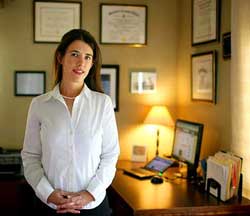
- Margo Drakos, co-founder/COO of InstantEncore
Margo Drakos is a woman on a mission. The co-founder and COO of InstantEncore wants to take classical music directly to its audience via a host of online services, including a digital strategy package for powering custom websites for organizations, a website builder for artists and the development of mobile apps. Recently, the company has been busy building custom mobile apps for Android, iPad, iPhone and all smartphones. InstantEncore’s mobile apps have previously been featured on this blog in Tom’s article 10 Arts and Culture Mobile Apps from 2010.
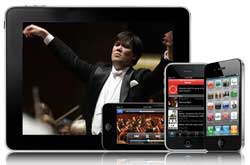 InstantEncore currently powers about 100 iPhone apps and 50 Android as well as hosting mobile web apps, which make an organization's website functional on a mobile phone. Their platform powers the app for the popular YouTube Symphony Orchestra, which, at over 125,000 downloads, and beats both the Taylor Swift and Linkin Park apps by about 90,000. Instant Encore also hosts the apps of notable organizations like the NY Philharmonic, Chamber Music Society of Lincoln Center, Cleveland Institute of Music and Houston Grand Opera.
InstantEncore currently powers about 100 iPhone apps and 50 Android as well as hosting mobile web apps, which make an organization's website functional on a mobile phone. Their platform powers the app for the popular YouTube Symphony Orchestra, which, at over 125,000 downloads, and beats both the Taylor Swift and Linkin Park apps by about 90,000. Instant Encore also hosts the apps of notable organizations like the NY Philharmonic, Chamber Music Society of Lincoln Center, Cleveland Institute of Music and Houston Grand Opera.
I talked with Margo recently to catch up on Instant Encore's latest endeavors.
What is InstantEncore? InstantEncore.com is a classical music platform that enables artists and arts organization to harness the power of technology to connect with their fans anywhere, any time. We are the infrastructure! We have created the only classical music-specific digital asset management system that essentially allows our Partners from a broad spectrum of the performing arts world to enter digital content – event listings, ticket selling, audio recordings (streaming, download, public or private), video (live or on-demand), news, blogs, and photos - one time, and have all of their content published in real time to their own website, mobile apps, Facebook or Twitter accounts.
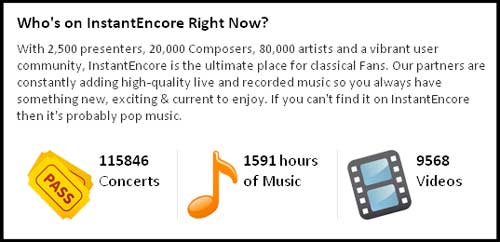 How did the idea for InstantEncore come about?
Two things happened: I was playing cello for a living and I had sort of grown frustrated with the disconnect between musicians and the audience, where the field was going, and how technology was disrupting the traditional models. I felt passionate about re-personalizing the concert experience without losing artistic integrity.
How did the idea for InstantEncore come about?
Two things happened: I was playing cello for a living and I had sort of grown frustrated with the disconnect between musicians and the audience, where the field was going, and how technology was disrupting the traditional models. I felt passionate about re-personalizing the concert experience without losing artistic integrity.
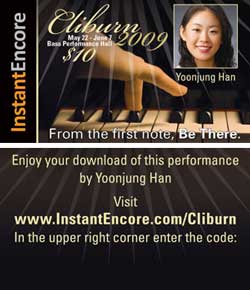
- An InstantEncore concert card offering a music download.
Meanwhile, I had the pleasure of meeting some wonderful engineers and they had a really powerful search engine specific for classical music that resulted in a high-end jukebox called Maestro. It had originally been created to help catalog vast CD collections, like that of our chairman/CEO. I was talking to them about how sometimes as a performer you would go to a live event and afterwards people would say “I loved the concert. How can I hear it again? How can I get a recording?” And of course I was always trying to sell some unrelated CD. So I talked to these engineers about this predicament that a lot of musicians always find themselves in, and so we actually created this concept of the “Instant Encore”—where you can take a card at the concert, go home, and download the content that you just heard.
How has InstantEncore evolved from the days of concert cards to now? Instant Encore started with a very powerful search engine that had organized and standardized all classical music meta data, and our objective was to build the tools that would enable fans to connect with the music and artists they love, in a personal, immediate way. We wanted to leverage technology to extend and enhance every aspect of the live concert experience. We are committed to providing the 21st century tools that will save organizations time and money by automatically or quickly powering their digital assets to connect with fans and engage sponsors.
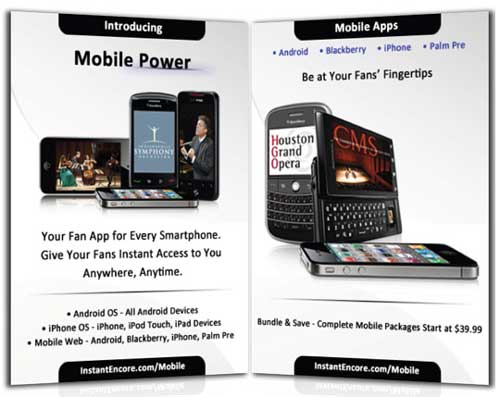
How does the Instant Encore component fit in with an organization’s existing social media presences and organizational website? Our goal is to streamline redundancies and save resources. Right now, you have a lot of people that are trying to update their website, spending a great deal of time developing a content management system internally instead of spending development time and resources on the front end. Then there is the mobile space--if an organization does not have a good web-browsing experience from a smartphone, people will close the site. Then organizations are manually pushing content that is often a PR push to Facebook and then to Twitter as well. So there’s a great amount of time and effort in trying to maintain all these very necessary social network platforms.
Obviously details about classical music can be a nightmare to organize or for data entry. We have a very standardized way—unless it’s a world premiere, it’s all in our search engine’s system. For example, if you start to type in “Beethoven Symphony No. 5”, it’s going to have the opus number and the key and all the movements and you just click on that and it’s automatically transferred. So, you’re never entering all that information yourself, which is 1) time-saving and 2) tagged at the most specific level, which allows people that are not looking specifically for you to find you and you that already know you and want to find you to customize their experience.
Our system is set up so that you as a Partner can enter an event listing in moments in our secure Control Panel. By that one simple event creation in our content management system, it updates in your website with our webbuilder or more advanced API (Application Programming Interface—see the end of this entry for more information). posts to the partner’s social networks, mobile apps, etc. You can do a host of different things—tag your YouTube channel. You can manually upload music for streaming or download purchase. Or you can create a private download code campaign for donors or concertgoers. One of our most valuable features is this web crawler that goes through hundreds of RSS feeds and finds articles specific to arts organizations and tag any article from newspapers or blog. This can automatically appear in your app or website as the latest news, so you’re not having to physically manage your app or site but your content is current.
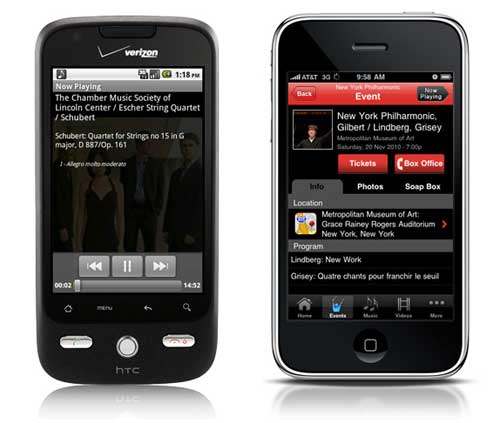 The music player feature on InstantEncore's Android app (left) and the events feature on InstantEncore's iPhone app (right).
The music player feature on InstantEncore's Android app (left) and the events feature on InstantEncore's iPhone app (right).
So basically it’s just a one-stop shop. It’s a digital asset management system where you come to enter your content in one place and it goes to all the platforms that you’re using. We’re just an aggregator and publisher of that content… Our concept was that it should be something that a two-person organization can use our tools and manage and have a very robust, beautiful integrated social media presence or an organization with a budget over 10 million can use the same tool.
Regardless of all the features you offer, many organizations might have trouble getting the rights to use pieces of music or convincing players that a mobile app is somewhere the music should be. What are some of the arguments you can make to convince them that this is something worth doing? I come from the musician/recording side of things, am a current member of the AFM and as a child was a member of AFTRA and SAG, so I certainly appreciate where the musicians are coming from. What I think is important is that, fortunately or unfortunately (however you want to perceive it) we’re in a new period that is such disruptive change, brought on in part by technology and change is always painful. There are new great opportunities but the existing models and the days of residuals in the way that we used to know it, at least right now, are not there. I think it’s really important to actually be very upfront about this. Artists are highly intelligent people and creative people and have wonderful ideas to bring to the marketing and development side of the business. I think it is so important that everyone be a stakeholder charting this new world together.
I think part of this is taking a holistic approach and saying that there are certainly a group of people that are going to want a physical CD’s and there’s people that are going to want to download content. But there’s a certain group of people know who just want what they want, when they want it. We see from our stats that music or videos are increasingly having a very short shelf life. People will often want to hear a new live recording over and over and then they move on and that is it. I often say to my friends and colleagues that you have to have some faith and work together to try things. Every community and every audience is different, but if you don’t have the tools to even explore or try things, that’s very challenging. I think mobile is so essential. People will be accessing the internet via their mobile devices more than from a computer within the next few years. If you don’t have a good user experience to access your content via mobile or any content in it, in my opinion, I think it will be very, very challenging.
You mentioned that you are focusing your research efforts on return on investment in digital media and how orgs can get sponsorship for their technology initiatives. Can you tell me more? Why should anyone care about social media and an integrated digital strategy? Why should anyone care about having a mobile app? I’m a very “nuts and bolts”, frugal person. When I look at some of the organizations that I work with and see how much they’re spending on print material and yet they don’t want to spend a few thousand on a mobile presence, or want to wait a few years to see where this mobile thing goes, I think it is quite alarming. Showing people the return on investment is critical for them to care.
Many organizations we are working with have packaged a digital or mobile sponsorship package and in many cases, new donors or people who were not previously interested in sponsorship at a significant level, are excited to be part of new technology, sponsoring live video streaming on websites and mobile platforms and much more.
It’s built into our platforms—ways for people to feature sponsors, going through their audience to create new audiences, etc. What I’ve found is that I’ve been pushing organizations to think outside of their printed program with a printed logo and think, how can we think outside of the box and take the old ways that we used to monetize and seek corporate sponsors and take this into the digital space? Some organizations have come up with some fabulous things. Whether it’s embedded streaming announcements featuring sponsors, ad spots with sponsors, getting grants to cover new educational and audience development initiatives—various things. They’ve been able to monetize this in new ways, from new sponsors (not cutting out of other things).
I am very excited that Telstra, the telecom company in Australia, hired us to create a premium custom app for the Sydney Symphony that will include live video streaming of ten concerts in their mobile apps and website. This is a win-win for everyone.
How should arts organizations approach technology? There are so many platforms out there, there is so much information and everything’s changing so rapidly. I remember launching the app with the New York Phil and at that time, apps were still—people thought “what the heck is that?” So, the most important thing is to integrate digital media strategy into organizational strategy—into every aspect of decision-making across all departments. It involves PR, it involves marketing, it involves development, it involves operations, the audio recording department, musicians—absolutely everyone. I think that buy-in is essential. I think one of the most important things is just to start small and get permission to try something. If it doesn’t work, don’t let it validate that “this is never going to work” and if it’s a home-run, that doesn’t mean that it’s going to work the next time. It’s important to look at just getting started but with a clear, integrated strategy approach. And really, actually, there’s a lot of fear sometimes when it comes to technology and I think part of what’s been fun to see is that oftentimes, it’s a lot more fun than people necessarily anticipate and I think that that’s been a really rewarding part of what we’re doing.
When Thomas Hampson made his recital available for download and Performance Today, Minnesota Public Radio, and European Public Broadcasting Union announced it on air. We read the comments from people from around the world—from United Arab Emirates, to Germany to California to Wisconsin—about how that music impacted them and how grateful they were for that. I was very honored and proud that some of our tools could be helping to connect the power of his voice and his artistry globally in a way that’s never happened before. I think that’s really what it’s about and instead of feeling more protectionist, as scary as it feels, to embrace democratized access in this engaged age.
More info on Maestro API:
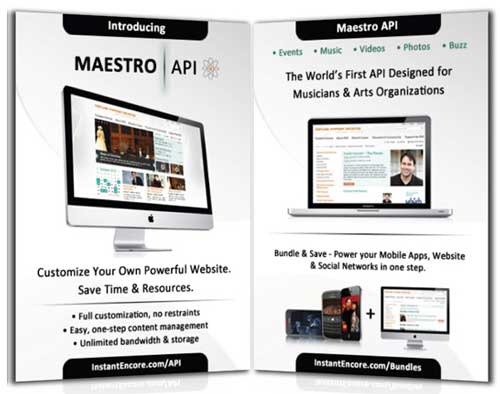
Livestream, Ustream, We all stream: A practical guide to streaming platforms
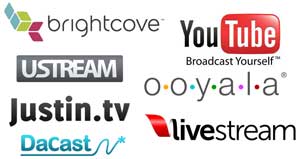
- With so many choices when it comes to streaming video, what's an arts organization to do?

A few weeks ago, I highlighted some emerging trends in arts marketing for 2011. One of the trends was “changing media consumption”, part of which includes arts organizations streaming performances live, whether to ballparks or online.
So let’s say that your organization is interested in streaming a performance live as it is happening or streaming a pre-recorded performance at a scheduled time. What are your options as far as platforms for streaming that video? And which organizations are out there using these platforms?
YouTube: The Non-option for Live Streaming
YouTube is the big name for online video, but livestreaming on YouTube will only be available for content partners. YouTube has not announced when livestreaming capabilities will go live. Approved by YouTube, content partners are people and companies that post regularly to the site and so that they can monetize their content with ads and rentals, obtain better digital quality for their uploads, and use YouTube’s Insight analytics tools.
You can apply to become a YouTube content partner to gain the above benefits. They have a special program specifically for nonprofits that currently includes arts organizations like Anaheim Ballet, MOMA, and Pilobolus Dance.
So when should you use YouTube? As of now, it’s the most mainstream choice for video, and therefore the easiest platform on which to build a community. YouTube has also streamed major events involving the arts community, like the Guggenheim’s YouTube Play Event. You might use it to post clips of the streaming event after the event is over and to host videos long-term; but right now, don’t depend on YouTube to release streaming capability any time soon.
Brightcove/Ooyala: The Gold Standard
Brightcove is the high-end gold standard for streaming. Many major corporations use it, as well as arts organizations like San Francisco Ballet and the Royal Opera House. It’s best for larger companies with highly valuable and highly demanded content as well as companies who want to fully integrate their streaming efforts with other components of their technology portfolio, via APIs, SDKs and other programming tools. Ooyala has a similar high-end set up used by companies like TicketMaster and ElectronicArts. Brightcove and Ooyala are great for larger companies with a lot of resources at their disposal. However, the price may not be affordable for organizations likely to use livestreaming once a year and only intend to stream to computers or existing mobile platforms—as opposed to a projector that would require higher quality video or a customized mobile platform that would require extensive development.
Livestream, Ustream, and Justin.tv: The mainstream for livestreaming
You may be thinking, “Okay, Brightcove sounds great, but my organization is not nearly as big as the Royal Opera House.” The most popular choices for streaming video amongst American arts organizations are livestream.com and ustream.tv. Both platforms offer mobile integration, easy interfaces and most any other feature you would want. Livestream even offers monetization opportunities.
Justin.tv appears to be gaining market share, but fewer arts organizations are on it, and its audience tends to skew younger and more male than the other platforms. Organizations like Wolf Trap have streamed pre-recorded events on livestream, a necessity when subtitles must be entered. Last summer the organization’s opera company streamed a cabaret performance of two world premiere operas Bastianello by John Musto and Lucrezia by William Bolcom.
Lee Anne Myslewski, Administrative Director, described the opera’s choice to use Livestream. “We chose Livestream because the interface was the most intuitive and it seemed to work the most consistently on all platforms/browsers. (Intuitive is important!) We were also specifically looking for an integrated chat function so that the audience and the artists could interact in real time during the broadcast. The process was smooth – easy for even a non-video person to create. We did have some viewers struggle with the speed of the file and intermittent pauses, but that could have been due to any number of causes - file size, their connection speed, or traffic on the site. If we go forward with the project we’ll likely use them again.”
One of the most notable successes on Livestream was Misnomer Dance Theatre’s stream of a performance in April 2010, which reached 2,000 viewers in 19 countries. Organizations are not only using LiveStream and Ustream to broadcast perform footage, though. They are also using it for production diaries like Second Wind Productions, press conferences like the Detroit Symphony Orchestra and educational initiatives like the Orange County Public Schools Orchestra Programs.
DaCast: No fuss monetization
Increasingly, companies want to monetize online content, and a recent Pew study (good summary here by ReelSEO) shows that people will pay for it. Monetizing content can basically be done in two ways: generating revenue through advertising, or having the consumer directly pay for online content (pay per view), which can be on a one-off or subscription basis.
LiveStream requires $350 a month for their premium service, which includes opportunities for monetization. However, if you want to monetize your content with less financial commitment up front, DaCast is a sensible option.
DaCast describes itself as self-service model. In a way, all streaming services are self-service, but DaCast allows companies to monetize their content in the same self-service way that you can upload a video to YouTube. The only fees that you pay are for bandwidth, with a minimum $5 commitment. (The first 10GB are free, too.) Most excitingly, DaCast has developed a plug-in for Flash which allows users to pay directly on their video screens, rather than clicking through to another page.
The question is: could a paid model be right for your organization? As DaCast CEO Stephane Roulland said, “This is an excellent question.” Aggregated sites like classicaltv.com and Ovation are already monetizing content. Classicaltv uses the pay-per-view model while Ovation uses the ad-based revenue model. The Metropolitan Opera’s Met Player might be one of the one of the only single-organization streaming sites. The key is figuring out if your organization will break even on the fees to secure the rights and the fees to stream.
More resources:
- Here's a handy comparison chart from Streaming Media.
- If you are interested in learning about your options when recording said performance, check out our Making a Video webinar.
- You may also be interested in our Social Media, Video Footage & The Law white paper to read about clearing rights.
Social Media Spotlight: The ToonSeum
Welcome to the fifth installment of the Social Media Spotlight, our monthly feature focusing on arts organizations’ social media strategies.
How to allocate time and money towards both social media engagement and online marketing is different for every arts organization. To get a different perspective Technology in the Arts decided to talk with a smaller organization, the ToonSeum, about how they achieve their social media and online marketing goals with a limited staff. I had a chance to chat with Joe Wos, Executive Director of the ToonSeum, about his approach:
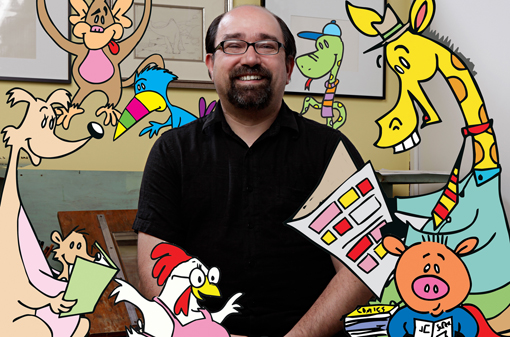
So Joe, what is the ToonSeum?
The ToonSeum is Pittsburgh’s Museum of Cartoon Art. It is one of only three museums in the country dedicated to the cartoon and comic arts. We offer rotating exhibitions covering all aspects of cartoons and comics, from animation and anime, to comic strips, comic books, editorial cartoons, illustration and much more. We also offer ongoing workshops, screenings and lectures.
It really is one of the most unique museums in Pittsburgh. Every city may have a version of a children’s museum or traditional art museum, but there are only three cartoon art museums! New York, San Francisco and Pittsburgh. We take great pride in our unique place in Pittsburgh.
What kind of marketing and PR challenges does the ToonSeum face?
Our number one challenge as with any small non-profit is budget. We are a small museum up against juggernauts! We are up to the challenge. If anything, budget limitations have led to creative thinking. You aren’t going to see us investing a lot in “traditional” advertising. Being a smaller museum also eliminates a lot of the fear of change you see from larger venues. We don’t have a huge investment in outmoded technology or ideas, so we are more inclined to let go and move forward to embrace new ideas in both marketing and tech.
We have been very lucky, the media both locally and nationally has been very supportive. Part of that attention is because of our approach to marketing. We use online marketing to create interest in “real world” experiences. We innovate new ways of reaching out. How many museums can say they had their own beer? Illustration Ale was a great success. We didn’t mail out postcards we used facebook.
In February we will launch our own themed hotel room in partnership with the Wyndham Grande downtown. It’s all about immersive experiences, translating virtual experiences we enjoy in gaming and through cartoons into the real world. That’s the kind of creative thinking we embrace.
A limited budget forces truly creative thinking.
Why did you choose to go with social networks/online marketing as a solution?
We are a fan-based museum. It’s a new approach to museum management, marketing and even exhibitions. Comic and cartoons by their very nature, are a fan-based medium. We embrace that. Just look at San Diego Comic Con, why is every major movie launching there? Because of the power fans have via social networks. We tap into those same fans. We are a geek museum, and proud of it. Our audience is very tech savvy, early adopters who can market virally better than anyone.
We know that the ToonSeum is a real world extension of a fan based virtual world. We are a museum of characters, icons and avatars. We want to become a real hub for comic and cartoon fans, and the only way to do that now, is through creating online connections and then inviting them to join us at the ToonSeum. Once we get them here, we know, they will tell their friends, strangers, tweet, blog, post, and tell the world about us.
We also recognize that it can’t be just virtual, you have to take it to the fans! We have booths at major Comic Cons, from San Diego to New York. We also host Blogger events and Tweet Parties at the ToonSeum. If we can get the word out to them about our exhibits and programs they will help us spread the word.
Beyond the standard social media efforts, such as a Facebook page and a twitter account, what other types of online efforts are the ToonSeum trying?
I worked for twenty years with a museum that had a real aversion to technology, it took a decade for them to come around. The ToonSeum is the opposite. We want to be the first. We were the first museum in Pittsburgh to have an I-Phone App. We may still be the only one! MailChimp, EventBrite, every new social marketing tool that comes out we give it a try. We were among the first to participate in KickStarter (we were even featured in the New York Times in an article about it.) I attend the Consumer Electronic Show in Las Vegas just because I know we need to stay at pace with the public. The technology in most museums is outdated, kids can do more advance and exciting interactions at home. So we reach out, we are a Beta Test museum. We put ourselves out there to new technology and say, let us try this out first!
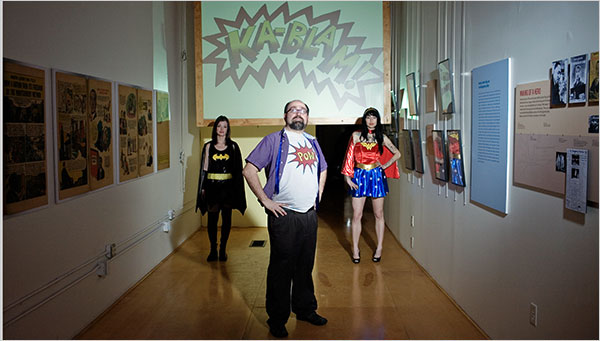
We have an ipad docent at the entrance. Any guests who wants to experience more online while in the gallery can use it as a tool.
For light up night we launched lights in our windows that can be controlled from the outside via an iphone. The guest has control over their experience before they even enter the door.
I am a self-professed geek and nerd, I attend the Consumer Electronic Show in Vegas every other year, I attend the Toy Fair in New York. I bring those innovations and ideas back to the ToonSeum and find ways to integrate them. So the ToonSeum has a giant screen projection in the center of our ceiling that loops cartoons. It is of course blu-ray 3d as well.
We have worked with Behar-Fingal to integrate QR codes into all our exhibitions. This allows guest with smartphones to link to additional content online. Whether it is a wikipage entry on the artists, or video we provide of the cartoonist at work. This is a great tool to take our exhibits beyond our walls and is also cost effective. People are walking around with access to all the information they need. In the future museums won’t need placard after placard of explanatory text. They will just need to provide a link. Their curiosity will take them beyond your walls. Each and every work of art is a potential jumping off point to a world of discovery in the world wide virtual museum.
We know that the traffic has to flow in both directions. A museum should be a destination from those on the web looking for real world experiences, but a museum must also be a gateway to curiosity that can be infinitely explored in new and exciting ways online.
Despite our using technology in so many ways, the ToonSeum is still ultimately about art on the walls. Because we have integrated ways to put the technology in your hands we don’t have to use a lot of monitors and computers. It makes it an individual experience, which is something we learned from social marketing. Everyone wants to interact on their own terms.
I know you operate on a small staff, how does this affect how you manage your various online efforts?
We have a social marketing intern whose only job is to tweet and post. That’s a must! The museum has to have a presence online that allows for immediate interaction. So we respond to every tweet that mentions us, every facebook post. It’s time consuming but it is the most important aspect of social marketing… being social!
All of our staff also has access to post to our various accounts. So we are updating daily. More important though is the fact that our fans are out there, retweeting and posting everything for us. It gives us a much bigger presence.
They also know to speak with the ToonSeums voice. It’s always connected to our mission and not personal. I have seen top-notch museums whose official facebook page has post about their kids getting the flu! Unless there is an epidemic of every kid visiting your venue getting the flu, how does a museum have kids that get sick? It doesn’t. Your venue has to have a virtual identity, a voice that your fans can interact with and it has to be consistent.
This is all easier to accomplish with a small staff. There are no committees, no approval process, no budget meeting, we identify what needs done and do it!
Does your staff size affect how you track the success of all of your online projects?
Every guest that comes in is asked how they heard about us, and their zipcode. We track every single opened email and clicked link. That data is all placed into a matrix we use to measure our success. It doesn’t take a big marketing firm, it just takes a commitment of a few minutes each day.
Can we talk about the Bloggers Blast? What is the event and why focus on bloggers?
I was at the Consumer Electronics Show in Vegas and attended about 5 after parties. What impressed me was they were all geared toward bloggers and social media. I knew this was something the ToonSeum had to do in Pittsburgh.
Traditional press is great, we love them! But today even they are pulling content from bloggers. Bloggers have fans, just like we do. It comes back to embracing a fan-based culture. So we wanted to let those bloggers get a sneak preview at our upcoming exhibitions and programs for 2011. We have special guests, a preview of the art, prizes and every single blogger will get a flash drive filled with all our press releases, promo art and more. If you are reading this and are a blogger, contact joe@toonseum.com for your invite.
We will be following this with tweet parties, where everyone is admitted free if they tweet about the exhibits.
You have mentioned that the ToonSeum was one of the first Pittsburgh museums to develop an iPhone app. What does the app do and what was the development process like? Has there been a good response?
Going to back to my previous experience with another museum, I was often frustrated by the phrase “we’ll look into it.” I began to realize that phrase meant, we don’t know how to do it and aren’t willing to learn. Forget the yellow pages, the phone book is dead. It’s all about web and apps. We knew we needed an iphone app. It provides immediate access to enhance the guest experience. It also goes a long way to legitimizing you to tourist. It’s one of the first things I do when I visit a venue in a new city, I check them out online and then download their app.
Creating an app can be an expensive prospect, thousands of dollars. That was out of the question for our budget. So, I just learned to do it myself. I applied for an apple developer license, found a great site that would allow me total control over the creation of the app, submitted it for approval and that was it. Total process took about five hours, not counting waiting for approvals, which took three weeks. I used rss feeds so that info on our hours and events could be changed on the fly. I created a framework that would allow our youtube videos to be viewed from within the application. As a cartoonist it was easy to do most of the graphic design work myself and there you go. It’s done. Our social marketing intern can update it from anywhere. I can even update from my iphone when I am out of town.
If I am going to run a museum I should know how to do every job. I better know how to market, run the register, curate an exhibition and even mop the floors. I can then have a better understanding of how difficult a task is and more important I can lend a hand when it is needed.
I am working on an android app right now and we are doing a complete web overhaul in spring.
We are geeks, we love this stuff.
Planning for Engagement: Tech Strategy & the Visitor Experience
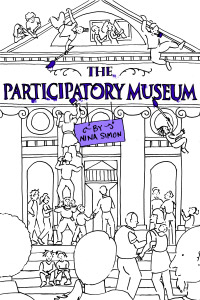 Earlier this week, the Pittsburgh Children’s Museum hosted a talk by Nina K. Simon, author of The Participatory Museum and the Museum 2.0 blog. Simon works with museums throughout the country to develop programs for improving visitor engagement.
Earlier this week, the Pittsburgh Children’s Museum hosted a talk by Nina K. Simon, author of The Participatory Museum and the Museum 2.0 blog. Simon works with museums throughout the country to develop programs for improving visitor engagement.
Simon brought up some great ideas about the ways in which museums could use programming to increase engagement and create meaningful experiences between visitors. Might arts organizations be able to apply her ideas about museums when designing their own strategies with technology and social media?
Here are a few of her ideas from the talk and how I think they might be applied:
Museums should be seen as places for everyday use
Simon argued that many museums are seen as tourist destinations that have a long-standing stereotype of being a place to be visited maybe only once a year. This is also true for many other types of arts organizations. Many of us would like to see that change and for arts organizations to become places that people consider frequenting practically everyday. Social media could be a strong tool for stimulating this impression. Offering frequent, engaging content online and creating a personal connection with our organizations’ constituents can help counter the idea that arts organizations are aloof and impersonal tourist destinations. Social media offers an opportunity to communicate the frequent, sometimes daily offerings of your organization.
Museums should be trusted hosts for social experiences
Simon spoke last night about the success some museums have had with programs that involve voting, encourage competition, and prioritize face-to-face interaction between visitors. Arts organizations could apply this idea towards utilizing social event sites like meetup.com, where the end result is a real-life, social interaction. Or this idea could be applied towards using such tools as real time tagging of artworks from any discipline or mobile device voting systems as a way to create conversation and interaction between visitors. The Indianapolis Symphony Orchestra went the mobile voting route when they had audience members vote, via text, to choose which encore the symphony performed.
Museums should be places for seeing and exploring as well as sharing and making
Another great way to engage visitors in a meaningful way is to encourage them to share their experiences of the organization with their friends and to create their own content. Social networking sites are centered on this idea of sharing experiences online and many organizations have taken advantage of this by encouraging their visitors to share photos and stories on the organizations’ social networks. The Vancouver Opera has a flickr fashion page that gives visitors who have “dressed to the nines” a place to shine online. The Mattress Factory’s iConfess is a confessional booth for visitors to express their ideas about the museum and publish those ideas directly to YouTube. Photos and personal experiences are definitely visitor-created content, but current technology can push this idea of participation even further. The success the Guggenheim had with YouTube Play, an online exhibition of user-created videos, and online projects like The Johnny Cash Project, where users re-interpret a Johnny Cash video by drawing over each frame, are two great examples.
As technology and social networks continue to expand and grow at a rapid rate, it’s hard to know which to develop programming for. These ideas presented at Ms. Simon’s talk can serve as great starting points to that conversation. As your organization moves forward developing technological programming, some questions should be asked, such as: Is the technology serving the end goal of bringing people to our institution? Is it helping to create a worthwhile experience for visitors, or is it just tech for tech’s sake? How varied of an audience can a particular technology or social network reach? Are there better, low-tech solutions to visitor engagement? New technology and advances in web 2.0 can offer powerful tools that can help expand audiences and increase visitor engagement, but remember to step back and look at which strategy best serves your organization's visitors and creates a meaningful experience.
Fill in the ________: A New, Social Entertainment Website
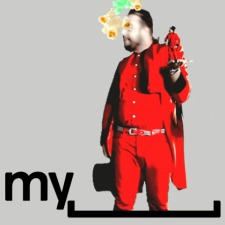 MySpace, the original social networking site, has relaunched and re-branded itself as My_______ ,the world's first “Social entertainment” website. The purpose of the website has shifted from a social networking site motivated by the slogan “a place for friends” to a site intent on “becoming the leading entertainment destination that is socially powered by the passions of fans and curators.”
Essentially, the new My_______ focuses less on people and more on media and digital content sharing. The sleek new site combines the most popular features of Facebook, Twitter, Foursquare, and Youtube into a single media focused platform. Users can now follow artists and organizations on topic pages, similar to Facebook fan pages, while receiving real time updates on the music, videos and content being heard, viewed, or uploaded by them (very reminiscent of Twitter).
MySpace, the original social networking site, has relaunched and re-branded itself as My_______ ,the world's first “Social entertainment” website. The purpose of the website has shifted from a social networking site motivated by the slogan “a place for friends” to a site intent on “becoming the leading entertainment destination that is socially powered by the passions of fans and curators.”
Essentially, the new My_______ focuses less on people and more on media and digital content sharing. The sleek new site combines the most popular features of Facebook, Twitter, Foursquare, and Youtube into a single media focused platform. Users can now follow artists and organizations on topic pages, similar to Facebook fan pages, while receiving real time updates on the music, videos and content being heard, viewed, or uploaded by them (very reminiscent of Twitter).
In this way, members will be able to see what music their favorite opera company is listening to as well as what they are posting. Users will be shown the media that their friends are consuming, not just the media that their friends and topics are posting. It opens a new opportunity for media recommendations, community building, viral marketing, and content sharing.
These updates appear on the new homepage now referred to as the dashboard which can be viewed in three modes: list, grid, or full screen.
The list mode looks almost exactly like a Facebook news feed. The grid view integrates watchable videos, playable songs, pictures, and micro-blogs in a chronological collage of media tiles, and the full screen mode allows users to experience their media updates in an interface similar to iTunes coverflow.
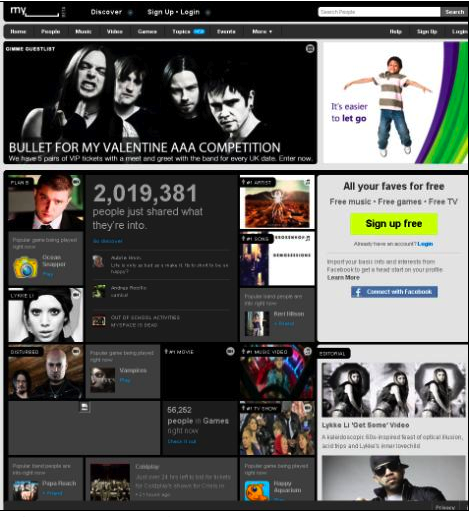
My_______ has combined multiple features from across the web that have never been offered in tandem before - creating a unique media viewing and sharing experience. Some of the other new features include: interactive games, karaoke (Opera?), free music playlists creation (competing with Pandora?), and media trending.
The new interface and combination of features could prove very useful to cultural institutions and arts managers if the user base is willing to readopt a floundering platform.
The largest obstacle for the new My______ is the old MySpace. The relaunch comes after one of the worst years in the company's history. MySpace lost 50% of its user base between 2009 and 2010, a critical hit for the organization and a terrible loss for its functional use as a communications tool and social network. The new My________ is much more in line with Internet usage interests and behaviors of Millenials, but it is not yet clear if they will return to the site.
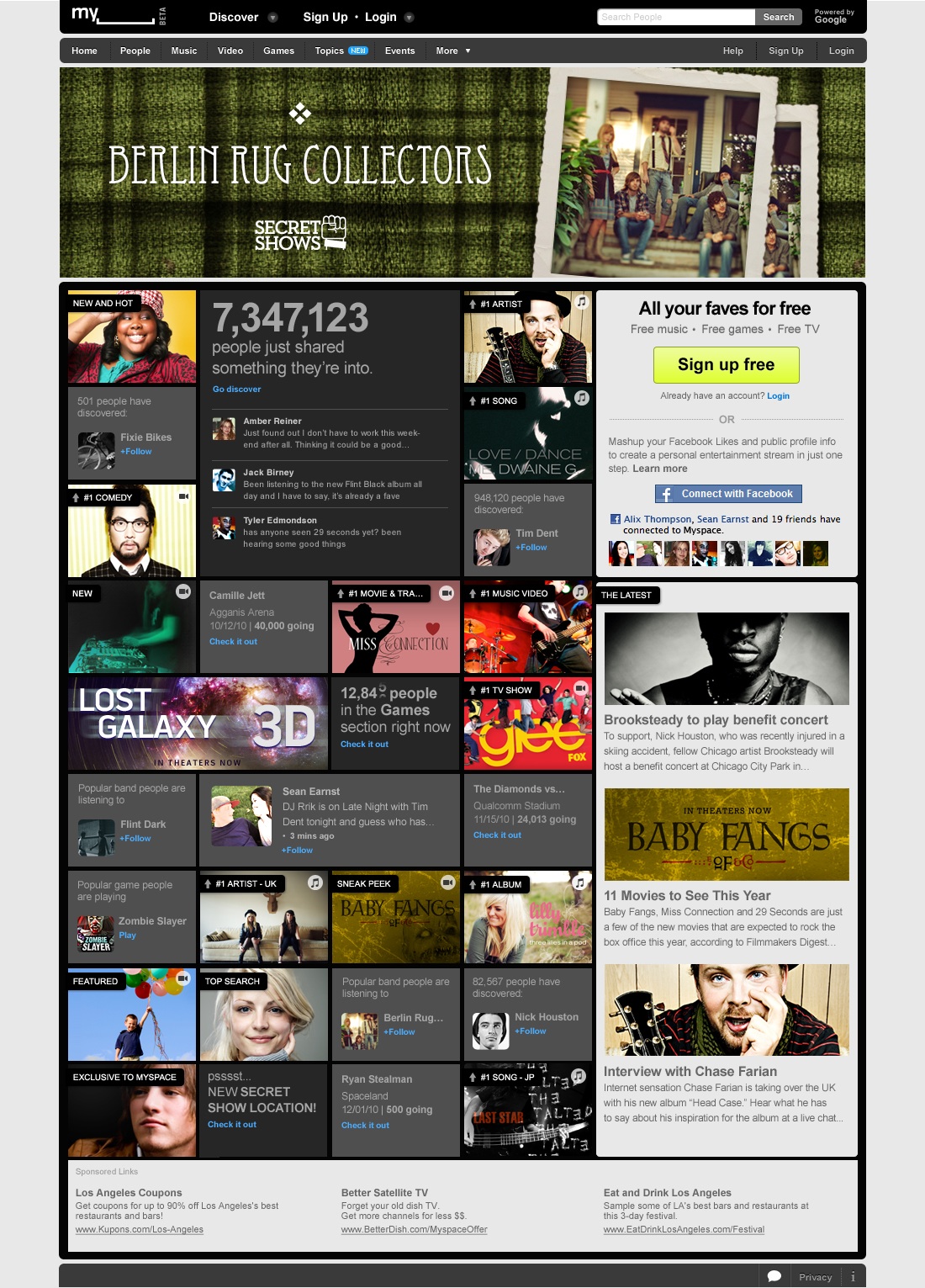 In order to make the transition smoother and help regain customers, My______ has paired with Facebook to create what they are calling a mashup, in which My_______ takes all of a user’s profile information, friends, and likes from Facebook and imports them into a My_______ page; making the process of setting up a new functioning account much quicker and helping users grasp the changes and full functionality of the site much faster. This partnership bodes well for My_______ and provides a clear focus away from social networking and onto new media and digital content sharing.
In order to make the transition smoother and help regain customers, My______ has paired with Facebook to create what they are calling a mashup, in which My_______ takes all of a user’s profile information, friends, and likes from Facebook and imports them into a My_______ page; making the process of setting up a new functioning account much quicker and helping users grasp the changes and full functionality of the site much faster. This partnership bodes well for My_______ and provides a clear focus away from social networking and onto new media and digital content sharing.
For arts organizations and non-profits that are currently tweeting links to content on Twitter, uploading videos to YouTube, and sharing pictures and events on Facebook, the new My_______ offers a single platform that will combine all three. A one-stop shop for all of your social entertainment and digital media needs. The ability for pictures and videos to appear directly in a news feed like Twitter but with a usable interface like Facebook is very desirable and something that I believe has huge potential. Pairing the interface with the content and media focus allows for a more streamlined experience that is not diluted by the social aspect of Facebook and Twitter. The New My_______ is definitely trying to steer away from content that does not surround music, media or artists in some way.
The ability to create opera karaoke, post audio excerpts from a concert, or share video from a stage production or event that are instantly previewable and clickable in a media focused feed that is more graphic than Twitter, less convoluted than a YouTube subscription, and easier to deliver than Facebook is very enticing. If users begin to adopt the new My_______, it seems only natural for organizations to follow. Only time will tell if this snazzy new facelift will take off, but the potential is definitely real.
Social Media Spotlight: The Guggenheim and YouTube Play
Welcome to the third installment of the Social Media Spotlight, our monthly feature focusing on arts organizations’ social media strategies.
This month’s spotlight is the Guggenheim Museum’s strategy with YouTube Play, the recently debuted biennial celebrating creative talent in the realm of online video. The response leading up to Youtube play was massive, with over 23,000 video submissions and over 46,000 subscribers to the YouTube Play channel. The channel, to date, has been viewed over 23 million times. 25 videos were selected by an esteemed jury and celebrated on October 21st with an event at the Guggenheim in New York that was live streamed worldwide.
I recently had a chance to chat with Associate Curator Hanne Mugaas about YouTube Play:
Where did the idea originate for the Guggenheim to team up with a social media site like YouTube?
The Guggenheim had already collaborated with Google on Design It: A Shelter Competition, where on the occasion of the exhibitions Frank Lloyd Wright: From Within Outward and Learning By Doing, the Guggenheim and Google SketchUp invited amateur and professional designers from around the world to submit a 3-D shelter for any location in the world using Google SketchUp and Google Earth. Ideas for new collaborations originated from this project, and a celebration of online video became the next step.
Instead of using their existing YouTube channel, the Guggenheim decided to create an entirely new channel for YouTube Play. What drove that decision? Did it have a positive effect on your original channel?
Since the project is a collaboration between YouTube and the Guggenheim, we wanted a channel for Play content exclusively. The fact that it is a biennial (the project will continue every second year) is another reason why we wanted a separate platform. The project has certainly had a positive effect on the Guggenheim YouTube channel, and it has made it possible for us to reach new audiences.
Since its creation last May, the YouTube Play channel has gained over 46,000 subscribers. How did the Guggenheim cultivate such a large number of fans?
The project is unique in its global scope, which has generated extensive interest. We got 23,358 submissions, which is unheard of in a traditional art context. The pairing of YouTube and Guggenheim made people curious about the outcome. Most importantly, the shortlist and the top 25 videos have a diverse range of high quality works; videos that make you want to spend time on and revisit the channel.
In addition to YouTube, the Guggenheim also has a major presence on other social networks and social media sites like Facebook, Myspace, Twitter, & Flickr. What roles did these other sites play in your social media strategy with YouTube Play? Did the fact that YouTube Play culminated with a specific event affect your overall social media strategy?
The social media sites were important in getting the word out, and to drive submissions. We also started a blog, The Take, which contextualizes the project through writing by art, film, and Internet experts. We did frequent YouTube Play updates on Facebook and Twitter to keep people informed about the progression of the project. These were certainly important tools for the event, especially to make people aware of the live stream, and the external projections on the Guggenheim building in New York.
Speaking of events, the Guggenheim took full advantage of YouTube's new streaming service to live stream the YouTube Play event from the Guggenheim Museum in New York City. How was your experience with streaming video?
The live stream was a very important element given the global scope of the biennial; this way, anyone anywhere could watch the event live. It was a successful experience for us, and the feedback has been very good.
What advice would you give to other, smaller arts organizations that want to experiment with live streaming their own events?
Streaming video is a great way to make your content available to a global audience, either it’s an event, a panel or a talk. To watch a live stream is special, and as a cultural producer, it is a great asset to know that people around the globe are watching.
Thanks again to Hanne Mugaas and the Guggenheim Museum. Visit the YouTube Play channel to check out the 25 selected videos from the exhibition and view selected clips from the live streamed event.
Is your organization doing exciting work in social media? Leave us a comment and let us know. We may feature you in an upcoming spotlight!
Why the Arts Matter - Video Contest Winner
Earlier this year, Americans for the Arts launched an online video contest to encourage U.S. residents over the age of 13 to answer the question, "Why do the arts matter to you?" Congratulations to all of the winners!
Online Video: We All Want The Same Thing
This post also appears as part of the Arts Marketing Blog Salon hosted by Americans for the Arts.
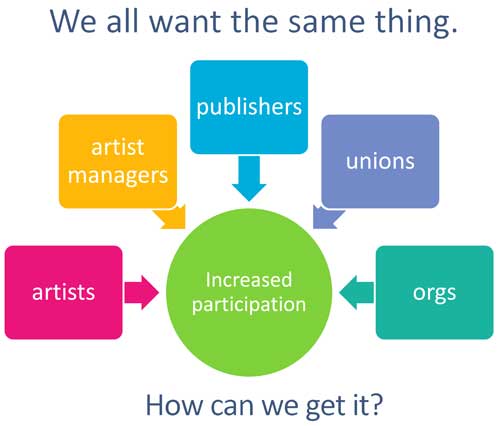 The world of arts management is changing, as all industries are changing, with the proliferation of technology. Especially with the increasing popularity of online media, we as arts managers have had to reconsider the way we see our performances. Is online video footage merely a vessel for our product? Or is it, in fact, our product? Or, can it also be a means to an end?
The world of arts management is changing, as all industries are changing, with the proliferation of technology. Especially with the increasing popularity of online media, we as arts managers have had to reconsider the way we see our performances. Is online video footage merely a vessel for our product? Or is it, in fact, our product? Or, can it also be a means to an end?
Many see social media and its democratization of internet content as the tool that will restore relevance to the arts, which critics claim is no longer present.
In recent weeks, we’ve seen changes in the social media landscape that make the issues surrounding performance footage all the more relevant. Twitter is adding video embedding capability. YouTube will soon be able to handle streaming video for content partners. These are signals of a trend that is already in progress—a movement of online video footage becoming not only accepted, but commonplace. Like it or not, online video is here to stay.
It was for this reason that I assembled a panel of experts on the rise of streaming video, and its interaction with our union relationships to speak at the NAMP Conference this November. It will be an opportunity to talk about the challenges that we face, as an industry, when it comes to video footage.
As an employee of an arts service organization and an arts management student at Carnegie Mellon, I’m in a unique position to examine performance footage in social media. Instead of having a vested interest in what would be best financially for a given organization, I can look at what is best for the arts industry as a whole and where the industry stands on these issues.
Over the past year, I’ve been looking at intellectual property issues as they pertain to performance footage. This research will culminate in an upcoming white paper for the Center for Arts Management and Technology. I’ve talked to unions, I’ve talked to organizations, and I’ve talked to artists. It’s fascinating to listen to their positions and how they perceive “the other side.”
Artists sometimes view online distribution of performance footage as a sort of Pandora’s Box: releasing their performance footage means relinquishing control of it and monetization of the content. They see organizations as trying to take advantage of their skills, or reducing the value of their work. Although they understand that organizations are struggling, they are struggling, too.
Organizations, on the other hand, are struggling with the realities of the economic downturn, as well as a decrease in newspaper circulation and in the general effectiveness of advertising in traditional media. They see new media as a lifeline, and take it on in order to secure their organization’s future. Some perceive that artists don’t equate saving the organization with saving the artform and the artist’s own career. This assumption leaves them puzzled and unsure how to proceed.
Although these positions seem diametrically opposed, both artists and organizations have common interests. In choosing and chatting with my panelists, who come from all different disciplines and affiliations, it seemed like there might be some fundamental conflicts between them. However, during our first conference call, I was amazed at how willing we were to listen and how much we genuinely wanted to understand each other’s viewpoints.
More often than not, I’ve found that we are all striving for the same thing—increased attendance, our own ensured success, and in turn, a bright future for the arts in America—we sometimes just have different ways of going about it.
Streaming, streaming everywhere
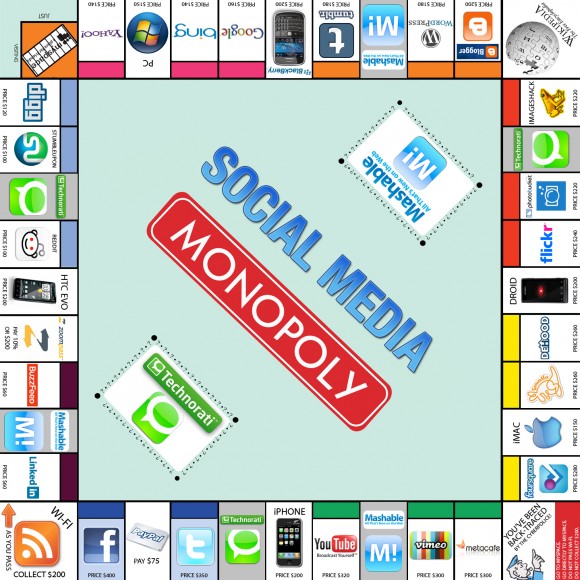 Last week YouTube did a two-day test to preview streaming capability, a move that would place them directly in competition with streaming sites such as livestream, ustream, and justin.tv. Streaming capability was available to four select YouTube partners — Next New Networks, Howcast, Young Hollywood, and Rocketboom for two days. Like the existing streaming sites, YouTube will allow for real-time comments and, eventually, embedding in widgets and archiving old streams.
Last week YouTube did a two-day test to preview streaming capability, a move that would place them directly in competition with streaming sites such as livestream, ustream, and justin.tv. Streaming capability was available to four select YouTube partners — Next New Networks, Howcast, Young Hollywood, and Rocketboom for two days. Like the existing streaming sites, YouTube will allow for real-time comments and, eventually, embedding in widgets and archiving old streams.
In all of YouTube’s communications , they only address giving this capability to their “content partners” anytime in the near future. YouTube content partners are people and companies that post regularly to the site and apply to YouTube in order to monetize their content with ads and rentals, obtain better quality for their uploads, and use YouTube’s Insight analytics tools. (Note: YouTube has a special program for non-profit partners. Check it out.)
Evan Rosenberg of Anaheim Ballet, a member of YouTube’s nonprofit program, produces the series “Anaheim Ballet: More Than Dance…” (See below for an excerpt.) He described the company’s hopes for its channel.
“YouTube has made it possible to not only showcase ourselves (Anaheim Ballet), but ballet in general to a global audience to the tune of over 24 million views. We look forward to using this additional tool (live streaming) in our continuing effort to spread the art of ballet across cultural, age, and economic boundaries.”
One of the videos on Anaheim Ballet's YouTube channel.
What are the implications for performing and performance arts organizations as streaming video becomes more and more ubiquitous? As a company or an artist, live performance is our product. Thus, we have faced issues with online video platforms since their rise in popularity:
We wonder if capturing that artistic product and distributing it online dilutes the aesthetic appeal.
We wonder if we should side with our artists and unions who deserve credit, payment, and a future in their industry, or with the insistent board member who says we must post video to capture the elusive younger market segment. We wonder if these interests are indeed in conflict.
We wonder if it cannibalizes box office revenues. And we wonder if we should give our audience members more credit; we know the difference between live performance and video, and so do they…right?
Online video is here to stay. This announcement is one more step in a long staircase of live streaming video becoming the norm. Fifteen years ago everyone had to have a website. Four years ago everyone had to have a Facebook page. Last year, everyone was going to mobile apps. With YouTube’s announcement, it’s easy to see performance footage moving from the movie theatre and the ballpark to laptops, phones, and iPads.
Speaking of new platforms for video, is everyone aware of the changes coming up for Twitter?
Baby Boomers, Facebook, and the Australian Example.
Reluctance to embrace social media as an appropriate avenue for reaching arts patrons has often been blamed on the demographics of the user base. Many people look at sites like Facebook and immediately write them off as platforms only representing a younger generation. Not any longer.
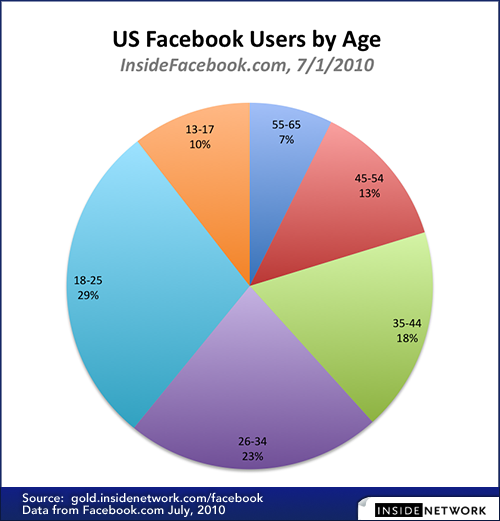 In 2010 educated adults over the age of 40 comprise the fastest growing demographic on Facebook, the age group 55+ grew by over 900%, and 40 million Facebook users in the US are now over the age of 40. This exposition of established professionals opens up the world of social networking even wider and begs the question: Are we properly using social media in the arts?
In 2010 educated adults over the age of 40 comprise the fastest growing demographic on Facebook, the age group 55+ grew by over 900%, and 40 million Facebook users in the US are now over the age of 40. This exposition of established professionals opens up the world of social networking even wider and begs the question: Are we properly using social media in the arts?
With 10 million Facebook users over the age of 55, Baby Boomers are staking their claim in the world of social media. This new demographic is college educated, professionally employed, and comprised of over 60% women. If that sounds familiar, you might be recalling the audience profile for the average arts patron in the U.S. The fastest growing segment on Facebook matches the traditional arts patron in the United States almost perfectly.
Other social media platforms have experienced similar growth outside of the traditional 18-34 age bracket. Currently users between 35 and 55 comprise the largest age bracket on Twitter. LinkedIn’s primary constituents are over 50 and MySpace continues its strong hold on original members now between the ages of 30 and 50.
These statistics along with the growing momentum around interactive websites, electronic outreach, and digital networking make social media the next frontier for audience development in the arts.
Innovations in social media within the arts have already sprouted around the country with great success:
- Characters from plays now have their own Facebook accounts to entice theatre goers to interact with them before and after the show.
- Interactive confession booths in galleries across the country load videos directly online for audiences to view and interact with.
- Viral online marketing is playing a larger and larger role in making buzz around productions and increasing web traffic.
But is it enough?
We can look to Australia for a prediction. Australia adopted social media faster that the US, UK or mainland Europe, with the highest user rates per capita in the industrialized world and the highest percent of users over the age of 35. Arts organization in Australia use Social Media to interact with patrons before, during, and after performances/exhibitions.
In the article Geeks, tweets and bums on seats, Elissa Blake discusses the adoption of social media in Australia and its affects on the arts. In the article, she writes about a production of King Lear where a woman asked permission to tweet during the performance. When asked why she did so, her response was:
It's about sharing your emotions and your experience of the show. You might have a favourite scene or a line that you love and you want to share it instantly. I thought King Lear might be dry, but it was really interesting, and I wanted my friends to go and see it...
Many Australian arts organizations and artists see social media platforms as a way for audience members to interact with companies, individual artist and each other. This interaction builds new passions for attending live performances as friends that could not attend receive enticing updates through their Twitter feed. This free viral marketing increases audience participation and makes Australia a leader of innovation in social media for the arts.
Fee Plumey, the digital program officer at the Australia Council for the Arts stated:
If arts companies want to attract new audiences, they have to jump in and chat about the minutiae of what's going on, Audiences are not just interested in a celebrity on stage. They really want to know how the show works, how the set was made, how it was cast, who's doing the lighting and what goes wrong… [social media provides that outlet].
Australia is a great case study for how social media can affect the arts. Now it is time for the US to see how social media can be creatively applied in audience development within our own country.
Guggenheim + YouTube = Awesome Biennial
Video may have killed the radio star, but it has done wonders in shifting the paradigm of visual art.
Since the 1960s, video art has been challenging preconceived notions about how art was supposed to look. At the time, these video artists had to fight to be recognized as worthy enough to be hanging in the same space as Monet or Picasso. And nowadays, you cannot walk into a contemporary art museum without some type of video art installation. Barriers were successfully broken down. Hooray!
Let’s take a quick look at the opposite end of the art world spectrum. A magical little land on the internet where hours (and probably days) at a time can be spent: YouTube.
With the dawn of YouTube, absolutely anyone can have his or her two minutes of fame. There is everything from a rapping weatherman to the music of Windows XP, Daft Hands and the post-it Mona Lisa… and seriously? Can you even imagine life before this guy? I know I can’t.
So we have the art world, which is harder to crack than a walnut frozen inside a glacier, and then YouTube, which could not be easier.
What happens when these two worlds join forces? YouTube Play. A Biennial of Creative Video
The premise is to receive video art submissions from around the globe by people who may or may NOT consider themselves artists.
New. Exciting. Different. Weird. Animated. Confusing. Anything.
“We’re looking for things we haven’t seen before,” says Nancy Spector, deputy director and chief curator of the Guggenheim Foundation.
No pressure.
So what happens after videos are submitted? A panel will review all of the videos and narrow it down to 200. From those 200, 20 will be selected to show in the first Biennial of Creative Video at the Guggenheim Museums. Yes, museums. The show will be simultaneously running at the Guggenheim in New York City, Berlin, Bilbao, and Venice. All 200 finalists will have their videos shown on the YouTube Play Channel.
Partnering with the Guggenheim and YouTube, is Hewlett-Packard, who will be providing all the equipment at the museums to display the videos, as well as online tutorials about video basics such as editing and lighting.
So even if you know absolutely nothing about videos or video art, your work could be shown in one of the most renowned museums in the world. Interesting. And exciting. I think.
What are your thoughts? Will this produce great art worthy of showing in Guggenheim museums around the world? Is that even the point?
Now there is a question worth exploring… In this rapidly changing world where absolutely anyone with a camera, phone, or computer can create “art,” how do you define what is museum worthy anymore?
I think there are two schools of thought on the matter. On the one hand there are the purists who think the art world should remain an elusive and elite club that few artists ever manage to penetrate. Unfortunately, these limitations of access are crippling to the sustainability of our field. Which is what the focus should be, according to the second group. Yes, the art world must educate, question, and preserve beautiful and interesting things, but if you can’t get people to walk through the doors then what is the point? Keeping today’s audience engaged with art, regardless of the means, has become a focus for both visual and performing arts organizations. Technology is a great entry point, because everyone understands it and uses it on a daily basis. The same holds true for artists. Almost every artist I am friends with uses technology in some fashion to produce their work. They are creating amazing things, but the likelihood of top curators and critics ever hearing about them is slim to none. Which is why YouTube Play is such a great concept.
Obviously, there will be no way of creating installation style pieces similar to Bill Viola’s piece for the 2007 Venice Biennale, Ocean Without a Shore. But in this case, that is ok. Unknown artists get to show their work, interesting pieces will be created, and the museum doors will be as convenient as your computer screen.
The other day, we talked about crossing into different genres of art than you are used to… well here is your chance! Everyone is an artist.
Interested? Absolutely anyone in the world can apply by uploading your video (less than 10 minutes and created in the last 2 years) to the YouTube Play Channel. The deadline is July 31, 2010, so start creating!
Learning from PS22 Chorus, 2010 Webby Artist of the Year
PS22 Chorus’s 5 word acceptance speech.
They’re cute, they sing pop songs, and they made Tori Amos cry (in a good way).
And they have over 18 million views on YouTube.
On June 14th, the Webby Awards named PS22 Chorus its 2010 Artist of the Year “in recognition of their online contributions to music, popular culture and the online medium itself.” PS22 Chorus, a 5th grade chorus from a public school in Staten Island, joins the ranks of previous winners such as Trent Reznor and the Beastie Boys.
Formed in 2000, the chorus began to gain online popularity in 2006, shortly after choral director Gregg Breinberg (AKA Mr. B) started posting videos of the chorus. Celebrity blogger Perez Hilton started promoting the PS22 Chorus videos, and their legions of fans grew.
While your organization may not yet have celebrity fans -- and your work may or may not involve dozens of adorable children singing pop music -- it’s worth taking a closer look to see what other strategies worked for this group:
• Take advantage of YouTube’s channels. PS22 Chorus customized their YouTube channel to create a look all their own. And by encouraging subscriptions, they could notify interested viewers whenever they posted new content. With more than 27,000 subscribers (as of 6/30/2010), there’s an opportunity for new videos to viral.
• Promote across platforms. PS22 Chorus embedded YouTube videos on their blog, increasing their view count without having viewers leave the site. And, their YouTube channel prominently links back to the blog. With your own online presence, consider how easily followers can access your content from different platforms.
• Consider giving your unconventional marketing ideas a shot. PS22 Chorus’s fame was, as New York Magazine writes, accidental. Mr. B mentioned on a Tori Amos fan message board that he was teaching her songs to his students. He followed up with video posts. Amos was charmed, and months later the chorus performed for her in person.
• Don’t be afraid to have a personality. PS22 Chorus’s energy and excitement come across in their online presence. Finding your organization’s own voice can help you connect and engage with followers.
• And finally, update regularly with fresh content.
What else is PS22 Chorus doing right? Which Webby Award winners are inspiring you?
We Have A Castle, Write Us An Opera!
Every good castle needs an opera company, or so the Savonlinna Opera Festival of Finland would lead you to believe. They have been performing at St. Olaf’s Castle in Savolinna, Finland since 1912. The festival took a 50-year Hyades between 1917 and 1967, but since its re-inception in the 60’s has been known for its cutting edge works and operatic premiers. Starting in their 2010 season they have decided to push the envelope of innovation even further. The Savolinna Opera Festival is crowdsourcing an opera for its 2012 season through a new project: Opera By You 2012
They are asking the public to write an opera from beginning to end for their 2012 season. They want the world to create everything from the story, set design and costume design to the music and libretto. Savolinna is providing the performers, the crew, and an orchestra; the public is providing the opera.
To my knowledge this has never been done before in Opera and certainly not to this extent. The Savolinna Opera Festival is taking advantage of wreckamovie.com to host their crowdsourcing forum. The site was originally set up for crowdsourcing movies, but also seems to be working well for opera. The only major problem I could find was the lack of music sharing technology on the site. It is still not clear how the composers will collaborate on the score for the opera.
Currently, members are working on the plot synopsis for the opera within the online forum. There are ideas ranging from aliens to sea monsters and insurance salesman to princesses, a true amalgamation of creativity. The opera is still in its early stages of creation and nothing has been set in stone yet.
I was a little frustrated that I could not find any information on how they are going to decide which ideas to use. It is not clear from the website if the management is making those decisions or if the public is going to vote. I am personally a fan of putting as much ownership on the collaborators and public creators as possible. The idea that an opera company would forgo control and perform whatever the public wants to see is very exciting.
Opera By You 2012 has the potential to change the world of opera and set a new benchmark for the use of technology in the ‘high arts’. This project is breaking many of the stereotypes typically associated with this art form and opening opera to a much wider audience. Opera By You 2012 is not about tradition or ‘the classics’, it is about making new art and opening up an opportunity for the masses to interact with opera.
Technology is helping this arts organization reach out to the world and break down some of the barriers that keep many people away from the classical music realm. Crowdsourcing taps the collective creativity of everyone involved and creates a product that is not only designed for an audience, but by them. This type of innovation is what keeps the arts current in our society. It will be very interesting to see how this opera materializes and the impacts that it will have on the world of opera.







